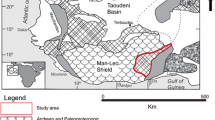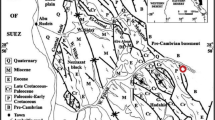Abstract
Standard petrographic methods were used to study 604 modern sands from South America, of which 351 came from rivers and 253 from beaches. In spite of the wide geomorphic contrasts, these sands belong to only three great families: (1) an immature Andean family of lithic arenites rich in volcanic and metamorphic grains that covers about 30% of South America; (2) a cratonic association rich in quartz that covers about 62% of the continent; and (3) a transitional, molasse association, which occurs between these two and covers only about 8% of the continent. The grand arithmetic average Q:F: Rf ratio for the entire continent is 60:11:29 and the area-weighted, carbonate-free average Qa:Fa:Rfa is 68:10:22, a superior continental estimate, and the first ever for an entire continent.
Rock fragments are the most informative of all the provenance indicators and in South America they range from tropical alterites of the cratonic family through the dominant volcanic and metamorphic grains of the Andean family to biogenic carbonate in beach sands. Carbonate grains are almost totally absent in modern South American rivers because of present day tropical weathering and a long geological evolution that has favored sand production. They are present in many of the beach sands, however, and are most abundant along the tropical Brazilian and Caribbean coasts. Metamorphic grains rival volcanics as earmarks of the Andean family and survive tropical weathering far better than volcanic grains.
There is a strong association between continental soil types and the composition of river sand, but the ultimate controls are tectonic history — the ancient landscapes preserved on the Gondwana shields of South America versus the tectonically young landscapes of the Andes — and climate. Climate can either cause ‘leaks’ to a far distant ocean where weathering is retarded by aridity or it can serve as a barrier to continental sand dispersion, where tropical weathering eliminates unstable grains in transit to the sea.
When provenance studies are conducted across an entire, unglaciated continent, events in the far distant past need to be considered when seeking fundamental explanations of its contemporary, surficial sands.
Similar content being viewed by others
References
Beek KJ, Bramao DL (1968) Nature and geography of South American soils. In: Fittkan EJ, Illies J, Klinge H, Schwabe GH, Sioli H (eds) Biogeography and ecology in South America. Vol. 1. Dr W Junk, The Hague, pp 82–112
Bennema J, Camargo M, Wright ACS (1962) Regional contrast in South American soil formation in relation to soil classification and soil fertility. International Soil Conference, New Zealand. Int Soc Soil Sci, Trans (Comm IV and V): 1–15
Bercowski F (1978) Variaciones mineralógicas en sedimentos del Río de la Plata. VII Congreso Geol Argentine, Neuquén, 9–15 April 1978, Vol II, pp 649–658
Bigarella JJ (Coordinator and Editor) (1978) A Serra do Mar e a porcào oriental do Estado do Paraná. Secretaria do Estado do Planejamento/Associão de Denfensa e Educacdo Ambiental, Curitiba, 248 pp
Blasi AM (1988) Argilominerales en sedimentos fluviales del Rio Colorado, República Argentina. Composición mineralógica y su evolución en la dirección de transporte. Univ Nac Plata, Rev Museo Plata 10, Geol No. 85: 113–125
Blasi AM, Mariassero MJ (1989) The Colorado River of Argentina: source, climate and transport as controlling factors in plate tectonic sand composition. J South Am Earth Sci 3: 65–70
Boggs, S, Jr (1992) Petrology of Sedimentary Rocks. MacMillan, New York, 707 pp
Braun, OPG (1971) Contribucão a geomorfologia do Brasil central. Riv Brasil Geogr 32: 3–39
Briceño HO, Schubert C (1990) Geomorphology of the Gran Sabana, Guiana Shield, southeastern Venezuela. Geomorphology 3: 125–141
Claisse MG (1972) Ètude de l'altération du quartz — en milieu tropical humide. R Acad Sci, Paris 274 (sec D): 2956–2959
Clarke FW (1924) The data of geochemistry. 5th edn. US Geol Surv Bull 770: 841 pp
Clearly WJ, Connolly JR (1971) Distribution and genesis of quartz in a piedmont — coastal plain environment. Geol Soc Am Bull 82: 2755–2766
De Celles PG, Hertel F (1989) Petrology of fluvial sands from the Amazonian foreland basin, Peru and Bolivia. Geol Soc Am Bull 101: 1552–1562
Dickinson WR (1989) Provenance and sediment dispersal in relation to paleotectonics and paleogeography of sedimentary basins. In: Kleinspehn KL, Paola C (eds) New perspectives in Basin Analysis. Springer Verlag, New York, pp 3–25
FAO-UNESCO (1970–81) Soil Map of the World, 1:5,000,000. FAO-UNESCO, Paris: 19 sheets
FAO-UNESCO (1971) Soil Map of the World, 1:5,000,000. Vol. 4. FAO-UNESCO, Paris: 193 pp
Franzinelli E, Potter PE (1983) Petrology, chemistry and texture of modern river sands, Amazon River System. J Geol 91: 23–39
Franzinelli E, Potter PE (1985a) Fraction analysis of modern river sand of Rios Negro and Solimoes, Brazil: implications for the origin of quartz-rich sandstones. Rev Brasil Geosci 15: 31–35
Franzinelli E, Potter PE (1985b) Areias recentes des rios de Bacia Amazoniaa: Composicões petrografia, textural, e quimica. Rev Brasil Geosci 15: 213–220
Gay P, Jr (1962) Origen, distribution y movimiento de las arenas eolicas en el area de Yanca a Palpa. Soc Geol Peru 37: 37–38
Ginsburg RN (1982) Seeking answers: suggestions for students. J Sedim Petrol 52: 351–352
Haughton PDW, Todd SP, Morton AC (1991) Sedimentary provenance studies. In: Morton AC, Todd SP, Haughton PDW (eds) Developments in Sedimentary Provenance Studies. Spec Publ Geol Soc London No 57: 1–11
Inman DL, Nordstrom CE (1971) On the tectonic and morphologic classification of coasts. J Geol 79: 1–21
Irion G (1983) Clay mineralogy of the suspended load of the Amazon and of the rivers of the Papua-New Guinea Mainland. Mitt Geol Paleontol Inst Univ Hamburg 55: 483–504
Iriondo M (1993) Geomorphology and late Quaternary of the Chaco (South America): Geomorphology 7, 289–303
Johnsson MJ (1990a) Tectonic versus chemical-weathering controls on the composition of fluvial sands in tropical environments. Sedimentology 37: 713–728
Johnsson MJ (1990b) Overlooked sedimentary particles from tropical weathering environments. Geology 18: 107–110
Johnsson MJ, Stallard RF, Meade RH (1988) First cycle quartz arenites in the Orinoco River Basin, Venezuela and Colombia. J Geol 96: 263–277
Johnsson MJ, Stallard RF, Lundberg N (1991) Controls on the composition of fluvial sands from a tropical weathering environment: sands of the Orinoco River drainage basin, Venezuela and Colombia. Geol Soc Am Bull 103: 1622–1647
Jordan TE, Gardeweg PM (1989) Tectonic evaluation of the central Andes. In: Ben-Avraham Z. (ed) The evaluation of the Pacific Ocean Margins. Oxford University Press, New York, pp 191–207
Kiel H (1955) Heavy mineral investigations of samples of Surinam. Geol Mijnbouk Ned 4: 93–103
Krook L (1969) Investigations on the mineralogical composition of the Tertiary and Quarternary sands in the northern Surinam. Verh Kon Ned Geol Mijnbouwk Gen 27: 89–100
Kroonenberg SG, Hoorn MC (1990) Bulk geochemistry of Tertiary and Quarternary fluvial sands in the Colombian Andes. Chem Geol 84: 92–95
Landim PMB, Bosio NJ, Wu FT, Meyer AE, Jr Castro PRM (1978) Heavy minerals from the Amazon bed. EOS 58: 277
Maynard JB (1984) Composition of plagioclase feldspar in modern deep sea sands: relationship to tectonic setting. Sedimentology 31: 493–502
Meigs P (1953) World distribution of arid and semiarid homoclimates. In: Reviews of Research on Arid Zone Hydrology. Arid Zone Program. Vol. 1. UNESCO, Paris, pp 203–209
Melfi AJ, Petoo G (1977) Estudo geoquimico des solos e formacões superficiais do Brasil. Parte 2 Characterizacão e reparticão dos principais tipos de evolucão pedogdo quimico. Rev Brasil Geosci 7: 271–286
Millot G (1964) Geologic des Argiles. Masson et Cie Editeurs, Paris, 499 pp
Morello J (1984) Perfil ecológico de Sud America Vol. 1. Institute, de Cooperacion Ibero Americana, Ediciones Cultura Hispanic, Barcelona, 93 pp
Ollier CD (ed) (1985) Morphotectonics of passive continental margins. Z Geomorphol Suppl 54: 117 pp
Pomar H, Bertoldi de (1980) Sedimentologia de las arenas del cauce de Rio Paraguay II. Composición mineralógica. Rev Asoc Cienc Nat Literal 11: 101–124
Pettijohn FJ, Potter PE, Siever R (1987) Sand and Sandstone. 2nd edn. Springer Verlag, New York, 553 pp
Potter PE (1978) Petrology and chemistry of modern big rivers. J Geol 86: 423–449
Potter PE (1984) South American modern beach sand and plate tectonics. Nature 311: 645–648
Potter PE (1986) South America and a few grains of sand: part 1, beach sand. J Geol 94: 301–319
Potter PE, Franzinelli E (1985) Fraction analysis of modern river sand of Rios Negros and Solimoes, Brazil, implications for the origin of quartz-rich sandstones. Rev Brasil Geosci 15: 31–35
Rich JL (1942) The Face of South America. Spec Pub] Am Geogr Soc No 26, 299 pp
Riezebos PA (1982) Heavy mineral and grain-size analysis of modern river sediments from the Rio Magdalena Valley (Colombia). INGEOMINAS No. 7: 132 pp
Ronov AB, Mikailovskaya MS, Solodkova II (1966) Evolution of the chemical and mineralogical composition of arenaceous rocks. In: Chemistry of the Earth's Crust Vol. 1. USSR, Acad Sci Isr Progr Sci Transl: 212–262
Savage KM, Potter PE (1991) Petrology of modern sands of the Rio Guaviare and Inirida, southern Colombia: tropical climate and sand composition. J Geol 99: 289–298
Savage K, de Cesaro P, Potter PE (1988) Mineralogic maturity of modern sand along a high energy tropical coast. Baixada de Jacarepaqua, Rio de Janeiro, R. J., Brazil. J South Am Earth Sci 1: 317–328
Scheidegger KF, Krissek LA (1982) Dispersal and deposition of eolian and fluvial sediments off Peru and northern Chile. Geol Soc Am Bull 93: 150–162
Scholten JJ (1971) Geomorphology. In: FAO-UNESCO Soil Map of the World 1:5,000,000. Vol. 4. South America. FAO-UNESCO, Paris, pp 35–42
Schubert C, Huber O (1990) La Gran Sabana: panorámica de una región. Cuadernos Lagoven, Caracas, 107 pp
Schwerdtfeger W (ed) (1976) Climates of Central and South America. Elsevier, Amsterdam, World Survey of Climatology No. 12. 532 pp
Short NM, Blair RW, Jr (1986) Geomorphology from Space. NASA Spec Publ No 486. Scientific and Technical Branch, Washington, DC, 717 pp
Sick WD (1968) Geographical substance. In: Fittkau EJ, Illies J, Klinge H, Schwabe GH, Sioli H (eds) Biogeography and Ecology in South America. Vol. 2. Dr W Junk, The Hague, pp 449–474
Siegal S (1956) Nonparametric Statistics for the Behavorial Sciences. McGraw Hill, New York, 312 pp
Simkin T, Siebert L, McClelland L, Melson WG, Bridge D (1979) Volcanoes of the World, a Regional Directory, Gazetter and Chronology of Volcanism During the First 12,000 years. Smithsonian Institute, Washington, DC
Squires VR (1988) Landscape: a southern hemisphere perspective. Earth-Sci Rev 25: 481–484
Stallard RF, Koehnken L, Johnsson MJ (1989) Weathering processes and the composition of inorganic material transported through the Orinoco River System, Venezuela and Colombia. Geoderma Sp Is (Weathering and Soils) : 133–166
Summerfield MA (1991) Global geomorphology. Longman, Harlow/Wiley, New York, 537 pp
Tricart J (1975) Influence des oscillations climatiques récentes sur le modelé en Amazonie Orientale (Region de Santarem) d'apres les images radar lateral. Zeit Geomorphologie 19: 140–163
Working Party Report (1990) Tropical residual soils. Geological Society Engineering Group Working Party Report. Q J Engin Geol 23: 1–101
Yerino LN, Maynard JB (1984) Petrography of modern marine sands from the Peru-Chile Trench and adjacent areas. Sedimentology 31: 83–89
Zonneveld JIS (1985) Geomorphological notes on the continental border in the Guyanas (N. South America). Z Geomorphol Suppl 54: 71–83
Author information
Authors and Affiliations
Rights and permissions
About this article
Cite this article
Potter, P.E. Modern sands of South America: composition, provenance and global significance. Geol Rundsch 83, 212–232 (1994). https://doi.org/10.1007/BF00211904
Received:
Accepted:
Published:
Issue Date:
DOI: https://doi.org/10.1007/BF00211904




